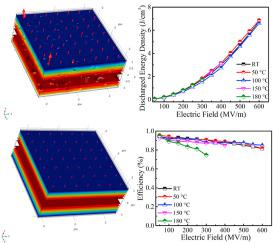当前位置:
X-MOL 学术
›
Compos. Sci. Technol.
›
论文详情
Our official English website, www.x-mol.net, welcomes your feedback! (Note: you will need to create a separate account there.)
Enhancement Thermal Stability of Polyetherimide-based Nanocomposites for Applications in Energy Storage
Composites Science and Technology ( IF 9.1 ) Pub Date : 2021-01-01 , DOI: 10.1016/j.compscitech.2020.108501 Weijun Miao , Hanxi Chen , Zhongbin Pan , Xueliang Pei , Long Li , Peng Li , Jinjun Liu , Jiwei Zhai , Hui Pan
Composites Science and Technology ( IF 9.1 ) Pub Date : 2021-01-01 , DOI: 10.1016/j.compscitech.2020.108501 Weijun Miao , Hanxi Chen , Zhongbin Pan , Xueliang Pei , Long Li , Peng Li , Jinjun Liu , Jiwei Zhai , Hui Pan

|
Abstract Improving thermal stability of high-performance polymer-based nanocomposite films for electrical energy storage is essential to meet ever-increasing demands for the electrical industry, especially at harsh environment applications. Here, the polyetherimide (PEI)-based composites films are prepared via grafting method in the presence of SrTiO3 (ST) nanofillers to substantially improved capacitive performances at elevated temperature. The composites films with the optimized filler compositions show a high discharged energy density of 6.76 J/cm3 under 600 MV/m at room temperature. Meantime, excellent high-temperature discharged energy density of 6.6 J/cm3 at 100 °C for the composites films is also achieved, which is superior to most of the previously reported. The simulations further demonstrate that the ST nanoparticles embedded into the composites films could effectively improve heat dissipation in comparison with pristine PEI matrix, resulting in enhancement high-temperature energy storage capabilities. This work gives considerable promise for high energy density polymer-based nanocomposite films capacitors under harsh environments.
中文翻译:

用于储能应用的聚醚酰亚胺基纳米复合材料的增强热稳定性
摘要 提高用于电能存储的高性能聚合物基纳米复合薄膜的热稳定性对于满足电气工业不断增长的需求至关重要,尤其是在恶劣环境应用中。在这里,聚醚酰亚胺 (PEI) 基复合材料薄膜是在 SrTiO3 (ST) 纳米填料存在下通过接枝方法制备的,以显着改善高温下的电容性能。具有优化填料组合物的复合膜在室温下在 600 MV/m 下显示出 6.76 J/cm3 的高放电能量密度。同时,复合薄膜在 100°C 下也实现了 6.6 J/cm3 的优异高温放电能量密度,优于之前报道的大多数。模拟进一步表明,与原始 PEI 基体相比,嵌入复合材料薄膜中的 ST 纳米粒子可以有效改善散热,从而增强高温储能能力。这项工作为恶劣环境下的高能量密度聚合物基纳米复合薄膜电容器提供了相当大的前景。
更新日期:2021-01-01
中文翻译:

用于储能应用的聚醚酰亚胺基纳米复合材料的增强热稳定性
摘要 提高用于电能存储的高性能聚合物基纳米复合薄膜的热稳定性对于满足电气工业不断增长的需求至关重要,尤其是在恶劣环境应用中。在这里,聚醚酰亚胺 (PEI) 基复合材料薄膜是在 SrTiO3 (ST) 纳米填料存在下通过接枝方法制备的,以显着改善高温下的电容性能。具有优化填料组合物的复合膜在室温下在 600 MV/m 下显示出 6.76 J/cm3 的高放电能量密度。同时,复合薄膜在 100°C 下也实现了 6.6 J/cm3 的优异高温放电能量密度,优于之前报道的大多数。模拟进一步表明,与原始 PEI 基体相比,嵌入复合材料薄膜中的 ST 纳米粒子可以有效改善散热,从而增强高温储能能力。这项工作为恶劣环境下的高能量密度聚合物基纳米复合薄膜电容器提供了相当大的前景。



























 京公网安备 11010802027423号
京公网安备 11010802027423号